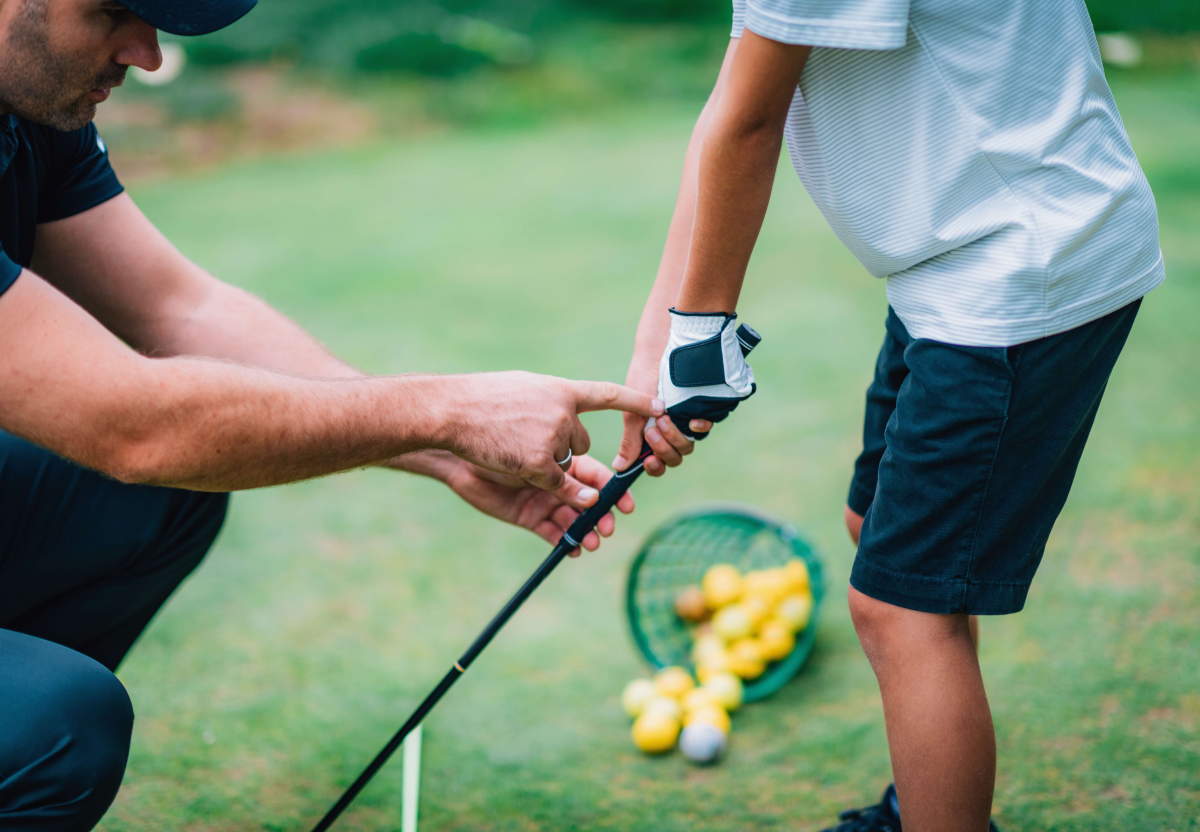
A golfer's grip is the foundation of a great golf swing, providing the only point of contact between you and your club. A proper grip enables control, consistency, and power throughout your stroke.
Whether you are a beginner learning the fundamentals or an experienced player refining your technique, mastering your grip can significantly improve your overall swing and shot accuracy.
But what is a proper golf grip, and why does it matter?
The Importance of a Proper Golf Grip
Learning how to grip the golf club is fundamental to achieving a consistent and effective swing. It influences how the clubface meets the ball, which in turn impacts shot trajectory, distance, and accuracy.
A proper grip ensures that your hands, arms, and body work in harmony, allowing for smooth, controlled movements throughout your swing.
- Control Throughout the Swing: Your grip is the key to controlling the club’s movement from the takeaway to the follow-through.
- Square Clubface at Impact: A well-placed grip helps you square the clubface at the moment of impact, leading to more accurate shots.
- Influence on Swing Mechanics: Your grip also affects wrist movement, hand positioning, and overall swing mechanics. These elements are crucial for generating power and maintaining control.
- Balance Between Power and Precision: A proper grip allows you to strike the ball with both power and finesse, leading to more consistent and reliable shots.
Three Main Types of Golf Grips
While there is no single "right" way to grip a golf club, there are three primary types of grips that players commonly use. Each grip style offers unique benefits, and the best one for you depends on your hand size, strength, and comfort level.
1. Interlocking Grip
The interlocking grip involves intertwining the pinky finger of your trailing hand with the index finger of your lead hand. This grip provides a firm and stable connection between both hands, offering greater control.
It is especially beneficial for golfers with smaller hands, as it ensures the hands work together as a unit. Many professional golfers, including Tiger Woods, use the interlocking grip.
2. Overlapping Grip (Vardon Grip)
In the overlapping grip, the pinky finger of your trailing hand rests between the index and middle fingers of your lead hand.
This grip is the most common among professional golfers because it offers an ideal balance of power and control. Golfers with larger hands often find the overlapping grip more comfortable.

3. Ten-Finger Grip (Baseball Grip)
The ten-finger grip involves placing all ten fingers on the club, with the dominant hand stacked directly under the non-dominant hand.
This grip is often recommended for beginners as it feels more natural and helps develop hand strength and control. However, it’s less common among advanced players because it can limit wrist flexibility.
Selecting a Golf Grip
There is no one-size-fits-all approach to choosing a perfect golf grip. What matters most is comfort, control, and how the grip feels during your swing.
While all three grip types serve similar purposes, experimenting with different grips will help you find the one that feels most natural and effective for your game.
How Hand Size Affects Grip Choice
Hand size plays an essential role in determining the right grip for you.
Here’s a general guide:
- Smaller Hands: Prefer grips that emphasize the fingers over the palms. The interlocking grip tends to work best.
- Larger Hands: Often more comfortable with the overlapping grip, allowing them to distribute the club’s pressure across both the palm and fingers.
Adjustments can also be made by adding or removing layers of tape under the grip to fine-tune the thickness, ensuring a proper balance of comfort and control.
Correct Hand Positioning on the Club
Once you’ve chosen your preferred grip style, hand placement is the next critical factor. Here’s how to position your hands for an effective grip:
Lead Hand (Left Hand for Right-Handed Golfers)
The club should rest diagonally across the fingers, not the palm, of your lead hand. This placement promotes a proper wrist hinge, enabling better control over the club’s release during your swing.
Trail Hand (Right Hand for Right-Handed Golfers)
Position your trailing hand through the base of the fingers rather than the palm. This allows for more flexibility in your wrists, which is crucial for controlling the clubface.
Both hands should form "V" shapes between the thumb and forefinger, which should point toward your rear shoulder. Aim to maintain consistent grip tension, typically about a 5 on a scale of 1 to 10, to avoid squeezing the club too tightly or holding it too loosely.
How Grip Affects Swing Mechanics
Your grip affects how the club moves during your swing.
A strong grip, where your hands are turned more to the right (for right-handed golfers), usually closes the clubface and helps produce a draw or hook. A weak grip, with your hands turned more to the left, leaves the clubface open, which can lead to fades or slices.
By understanding these effects, you can adjust your grip to control the direction of your shots and fix common mistakes.
Common Grip Mistakes and Solutions
Here are some of the most common grip-related mistakes amateur golfers may encounter and how to fix them:
-
Gripping Too Tightly: A tight grip restricts wrist movement and causes tension in your arms, reducing control.
Solution: Focus on maintaining a relaxed but firm grip, akin to holding a tube of toothpaste without squeezing it. -
Holding the Club in the Palm: This reduces flexibility and control.
Solution: Ensure the club is positioned more in your fingers, allowing for better wrist hinge. -
Too Strong or Too Weak of a Grip: If your shots are consistently hooking or slicing, your grip may be the culprit.
Solution: Adjust by observing how many knuckles you see on your lead hand—two knuckles typically indicate a neutral grip.
Adjusting Grip for Different Clubs
Your grip may vary slightly depending on the type of club you’re using:
- Driver: A neutral or slightly strong grip with firmer pressure helps generate power while maintaining control over the larger clubhead.
- Irons: A neutral grip with moderate pressure allows for precise control and accurate ball striking.
- Putter: Use a light grip pressure, with more emphasis on holding the putter in your palms, minimizing wrist hinge for a smoother putting stroke.
Grip Adjustments for Weather Conditions
Weather can also affect your grip, so it's important to adjust accordingly:
- Dry conditions: You’ll likely have more natural friction, making it easier to maintain a comfortable grip.
- Wet conditions: In rainy or humid weather, use golf gloves for better traction and increase your grip pressure slightly to prevent the club from slipping. You can also use a grip aid or towel to keep your hands dry.
Grip Improvement Drills and Exercises
Practicing your grip is essential for improving your swing. Here are a few drills and exercises that can help:
Grip Check Drill
Hold the club and close your eyes. Regrip the club multiple times, focusing on consistent hand placement. This helps develop muscle memory for proper grip alignment.
Grip Pressure Drill
Place a tee or coin between your thumb and forefinger and practice making swings without dropping it. This drill encourages consistent grip pressure and improves hand stability.
Off-Course Exercises
Strengthening your grip off the course is equally important. Wrist curls and reverse wrist curls help build the hand and forearm strength needed to maintain control during your swing.
Use Training Aids
Grip trainers are available to provide immediate feedback on your grip, and modern devices can even measure grip consistency and pressure, helping you fine-tune your technique.
Conclusion: Developing Your Ideal Golf Grip
The proper golf grip is an essential building block for developing a consistent, powerful, and accurate swing. While there’s no universal grip that works for everyone, finding the grip that suits your hand size, swing style, and comfort level is key.
Experimentation, practice, and attention to detail will help you discover your ideal grip. If you're struggling with your grip, seeking feedback from a golf instructor can provide valuable insights.
Mastering your grip is the first step toward improving your swing, enhancing your control, and ultimately lowering your scores on the course.
